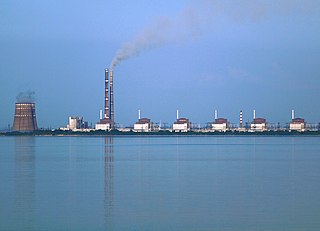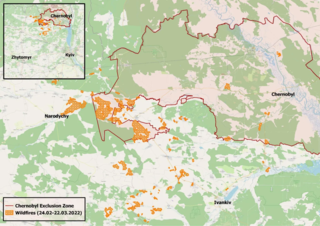| Nükleer Düzenleme Kurumu | |
 | |
| Agency overview | |
|---|---|
| Website | ndk |
The Nuclear Regulatory Authority is the regulator for nuclear power in Turkey. [1] [2] [3] Regulators are being trained in Russia and will oversee Akkuyu operated by Rosatom. [4]
| Nükleer Düzenleme Kurumu | |
 | |
| Agency overview | |
|---|---|
| Website | ndk |
The Nuclear Regulatory Authority is the regulator for nuclear power in Turkey. [1] [2] [3] Regulators are being trained in Russia and will oversee Akkuyu operated by Rosatom. [4]

The International Atomic Energy Agency (IAEA) is an intergovernmental organization that seeks to promote the peaceful use of nuclear energy and to inhibit its use for any military purpose, including nuclear weapons. It was established in 1957 as an autonomous organization within the United Nations system; though governed by its own founding treaty, the organization reports to both the General Assembly and the Security Council of the United Nations, and is headquartered at the UN Office at Vienna, Austria.
Nuclear engineering is the engineering discipline concerned with designing and applying systems that utilize the energy released by nuclear processes. The most prominent application of nuclear engineering is the generation of electricity. Worldwide, some 440 nuclear reactors in 32 countries generate 10 percent of the world's energy through nuclear fission. In the future, it is expected that nuclear fusion will add another nuclear means of generating energy. Both reactions make use of the nuclear binding energy released when atomic nucleons are either separated (fission) or brought together (fusion). The energy available is given by the binding energy curve, and the amount generated is much greater than that generated through chemical reactions. Fission of 1 gram of uranium yields as much energy as burning 3 tons of coal or 600 gallons of fuel oil, without adding carbon dioxide to the atmosphere.

Rosatom, also known as Rosatom State Nuclear Energy Corporation, the State Atomic Energy Corporation Rosatom, or Rosatom State Corporation, is a Russian state corporation headquartered in Moscow that specializes in nuclear energy, nuclear non-energy goods and high-tech products. Established in 2007 and comprising more than 350 enterprises, including scientific research organizations, a nuclear weapons complex, and the world's only nuclear icebreaker fleet.

The Zaporizhzhia Nuclear Power Station in southeastern Ukraine is the largest nuclear power plant in Europe and among the 10 largest in the world. It has been under Russian control since 2022. It was built by the Soviet Union near the city of Enerhodar, on the southern shore of the Kakhovka Reservoir on the Dnieper river. It is operated by Energoatom, who operate Ukraine's other three nuclear power stations.

The Kozloduy Nuclear Power Plant is a nuclear power plant in Bulgaria situated 180 kilometres (110 mi) north of Sofia and 5 kilometres (3.1 mi) east of Kozloduy, a town on the Danube river, near the border with Romania. It is the country's only nuclear power plant and the largest in the region. The construction of the first reactor began on 6 April 1970.

The water-water energetic reactor (WWER), or VVER is a series of pressurized water reactor designs originally developed in the Soviet Union, and now Russia, by OKB Gidropress. The idea of such a reactor was proposed at the Kurchatov Institute by Savely Moiseevich Feinberg. VVER were originally developed before the 1970s, and have been continually updated. As a result, the name VVER is associated with a wide variety of reactor designs spanning from generation I reactors to modern generation III+ reactor designs. Power output ranges from 70 to 1300 MWe, with designs of up to 1700 MWe in development. The first prototype VVER-210 was built at the Novovoronezh Nuclear Power Plant.

The Armenian Nuclear Power Plant (ANPP), also known as the Metsamor Nuclear Power Plant, is the only nuclear power plant in the South Caucasus, located 36 kilometers west of Yerevan in Armenia.
Nuclear power is a major power source in South Korea, providing 29% of the country's electricity. The total electrical generation capacity of the nuclear power plants of South Korea is 20.5 GWe from 23 reactors, equivalent to 22% of South Korea's total electrical generation capacity.

Tianwan Nuclear Power Plant is a nuclear power plant (NPP) on the coast of the Yellow Sea, approximately 30 kilometers east of downtown Lianyungang, Jiangsu Province, China. The plant's owner is Jiangsu Nuclear Power Corporation, a joint venture with majority owner a subsidiary of China National Nuclear Corporation (CNNC).
Energy in Kazakhstan describes energy and electricity production, consumption and import in Kazakhstan and the politics of Kazakhstan related to energy.

The Astravets Nuclear Power Plant is a nuclear power plant located in the Astravyets District, Grodno Region in north-western Belarus. The power plant is built close to the Belarus-Lithuania border, being 40 kilometres (25 mi) east of the Lithuanian capital of Vilnius. The plant is powered by two 1194-MW VVER-1200 units supplied by Atomstroyexport, the nuclear equipment exporter branch of the Russian nuclear corporation Rosatom. The plant is owned by State Enterprise Belarusian NPP, which in turn is owned by the state-owned operator Belenergo.

Energy in Armenia is mostly from natural gas. Armenia has no proven reserves of oil or natural gas and currently imports most of its gas from Russia. The Iran-Armenia Natural Gas Pipeline has the capacity to equal imports from Russia.
Currently, Turkey has no operating commercial nuclear reactors. However, four VVER-1200 reactors at the Akkuyu Nuclear Power Plant, are currently under construction and expected to come online in 2023. The government is aiming for 20 GW of nuclear.

The Akkuyu Nuclear Power Plant is a large nuclear power plant in Turkey under construction located in Akkuyu, Büyükeceli, Mersin Province. It is expected to generate around 10% of the country's electricity when completed.
The BN-800 reactor is a sodium-cooled fast breeder reactor, built at the Beloyarsk Nuclear Power Station, in Zarechny, Sverdlovsk Oblast, Russia. The reactor is designed to generate 880 MW of electrical power. The plant was considered part of the weapons-grade Plutonium Management and Disposition Agreement signed between the United States and Russia. The reactor is part of the final step for a plutonium-burner core The plant reached its full power production in August 2016. According to Russian business journal Kommersant, the BN-800 project cost 140.6 billion rubles.

The Rooppur Nuclear Power Plant (Bengali: রূপপুর পারমাণবিক বিদ্যুৎকেন্দ্র) is a 2.4 GWe nuclear power plant project in Bangladesh. The nuclear power plant is being constructed at Rooppur of Ishwardi upazila in Pabna District, on the bank of the river Padma, 87 miles (140 km) west of Dhaka. It will be the country's first nuclear power plant, and the first of the two units is expected to go into operation in 2024. The VVER-1200/523 Nuclear reactor and critical infrastructures are being built by the Russian Rosatom State Atomic Energy Corporation. In the main construction period, the total number of employees will reach 12,500, including 2,500 specialists from Russia. It is expected to generate around 15% of the country's electricity when completed.

Ukraine is home to four nuclear power plants, as well as the Chernobyl Exclusion Zone, site of the 1986 Chernobyl disaster. As of January 2024, both the Chernobyl and the Zaporizhzhia nuclear power plants saw battles during the war that resulted from the 2022 Russian invasion of Ukraine. The invasion has prompted significant discussion about the status of the power plants, including fears of potential disasters, and has also prompted debates about nuclear energy programmes in other European countries.

During the Russian invasion of Ukraine, the Zaporizhzhia Nuclear Power Plant has become the center of an ongoing nuclear safety crisis, described by Ukraine as an act of nuclear terrorism by Russia.